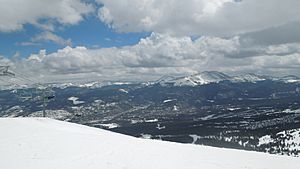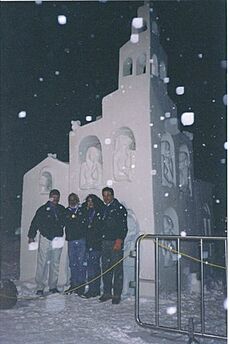Breckenridge, Colorado facts for kids
Quick facts for kids
Breckenridge, Colorado
|
|
|---|---|

Main Street in Breckenridge
|
|

Location of the Town of Breckenridge in Summit County, Colorado
|
|
| Country | |
| State | |
| County | Summit County |
| Established | November 1859 as Breckinridge |
| Incorporated | March 3, 1880 |
| Government | |
| • Type | Home rule municipality |
| Area | |
| • Total | 6.047 sq mi (15.661 km2) |
| • Land | 6.047 sq mi (15.661 km2) |
| • Water | 0 sq mi (0.000 km2) |
| Elevation | 9,601 ft (2,926 m) |
| Population
(2020)
|
|
| • Total | 5,078 |
| • Density | 840/sq mi (320/km2) |
| • Metro | 31,055 |
| Time zone | UTC−07:00 (MST) |
| • Summer (DST) | UTC−06:00 (MDT) |
| ZIP code |
80424
|
| Area code(s) | 970 |
| FIPS code | 08-08400 |
| GNIS feature ID | 2411722 |
| Website | www.townofbreckenridge.com |
Breckenridge is a town in Summit County, Colorado, United States. It is the county seat and the largest town in the county. In 2020, about 5,078 people lived there. Many people also have vacation homes in Breckenridge. The town is located at the base of the Tenmile Range mountains.
Since ski trails opened in 1961, Breckenridge Ski Resort has made the town a very popular place for skiers. In summer, Breckenridge attracts people who love the outdoors. You can find hiking trails, beautiful wildflowers, and great fly fishing in the Blue River. There's also mountain biking, boating on nearby Lake Dillon, and white-water rafting. Main Street has many shops and restaurants. The old buildings with their wooden exteriors make the town charming.
Breckenridge hosts fun events throughout the year. The Breckenridge Festival of Film happens in September. In January, the Backcountry Film Festival is often shown. In December, there's Ullr Fest, a week-long celebration of snow. It honors the Norse god Ullr. The annual Fourth of July parade is another popular summer event.
Contents
History of Breckenridge
People looking for gold came to what is now Summit County in 1859. This was during the Pike's Peak Gold Rush. They found gold near Idaho Springs, Colorado. Breckenridge was founded to support these miners. They found a lot of gold along the Blue River.
Miners first used placer mining, which collects gold from riverbeds. Later, they started hard rock mining. This meant digging tunnels to follow gold veins inside the hills. Gold was also found using hydraulic mining. Gold production slowed down in the late 1800s. But it picked up again in 1908 with gold dredging along the Blue River and Swan River. Overall, the Breckenridge mining area produced about 31,000 kilograms of gold.
Today, the gold mines around Breckenridge are closed. Some are open for tourists to visit. You can still see the gravel ridges left by the gold dredges along the Blue River and Snake River. The remains of an old dredge boat are still in a pond off the Swan River.
One famous early prospector was Edwin Carter. He was a naturalist who built a log cabin in 1875. He decided to collect wildlife instead of mining. His cabin is still there today. It has exhibits and a short film about his life.
In 1878, Harry Farncomb found a rich source of gold on Farncomb Hill. He found gold in unique wire, leaf, and crystal shapes. By 1880, he owned the whole hill. He later found a gold vein, which became the Wire Patch Mine. Other important gold veins were also discovered.
In the 1930s, a women's group in Breckenridge found an old map from the 1880s. This map did not show Breckenridge. They joked that Breckenridge was "No Man's Land" and not officially part of the United States. This was not true, as official maps did include the town. But these women used it as a clever way to promote Breckenridge.
In 1936, they invited the Governor of Colorado to Breckenridge. He came to raise a flag and "officially" welcome the town into the union. There was a big party, and the story made national news. The "No Man's Land" idea later changed to "Colorado's Kingdom." The town still celebrates its independent spirit every June during "Kingdom Days."
In December 1961, skiing began in Breckenridge. Trails were cut on Peak 8, connected to town by Ski Hill Road. Over the past 50 years, Breckenridge Ski Resort has grown a lot. It now covers Peak 9, Peak 10, Peak 7, and Peak 6.
Breckenridge has also been a filming location for movies. The 1989 comedy National Lampoon's Christmas Vacation was filmed here. The town also stood in for Aspen in the movie Dumb and Dumber.
Breckenridge Geography
Breckenridge is located at an elevation of 9,600 feet (2,926 meters) above sea level. The town has a total area of about 4.9 square miles (12.7 square kilometers). All of this area is land. The ski area itself covers about 4.5 square miles (11.7 square kilometers) of land.
Breckenridge Population
Breckenridge has grown quite a bit over the years.
- In 1870, there were only 51 people.
- By 1880, the population grew to 1,657.
- In 2000, there were 2,408 people living in the town.
- By 2020, the population reached 5,078 people.
Most people living in Breckenridge are White. A small percentage are Asian, Native American, or African American. About 5.44% of the population is Hispanic or Latino. The average age in town is about 29 years old.
Events in Breckenridge
Breckenridge hosts many public events throughout the year.
Winter Events
Every January, the International Snow Sculpture Championships take place. Sculptors from all over the world come to create amazing art from huge blocks of snow. The yearly Ullr Fest parade celebrates the Norse god of snow, Ullr. The Backcountry Film Fest also happens in January.
Since 2008, the Freeway Terrain Park on Peak 8 has hosted the Winter Dew Tour in December. This event features top snowboarders and skiers. Other mountain events include the Imperial Challenge, a triathlon-like race. There's also The 5 Peaks, a long ski mountaineering race. The Breck Ascent Series offers races up the mountain. The ski season ends with Spring Fever, a month-long celebration with live concerts.
Summer and Fall Events
In the summer, Breckenridge is home to the National Repertory Orchestra. The Breckenridge Music Institute also holds concerts. You can enjoy orchestra, smaller groups, and modern artists at the Riverwalk Center. This center is downtown near the Blue River.
Several art fairs come to Breckenridge each summer. They attract many local artists and art lovers. The town also has an annual Fourth of July celebration. It includes a parade in the morning and fireworks at night. In September, the Breckenridge Festival of Film has been held every year since 1981.
Notable People from Breckenridge
Many interesting people were born in or have lived in Breckenridge. Here are a few:
- Pat Ahern (born 1961), an Olympic Nordic combined skier.
- Edwin Carter (around 1830–1900), a miner who became a naturalist.
- Arielle Gold (born 1996), an Olympic bronze medalist snowboarder.
- Taylor Gold (born 1993), an Olympic snowboarder.
- Al Jourgensen (born 1958), a singer-songwriter and music producer.
- Katie Uhlaender (born 1984), an Olympic skeleton racer.
See also
 In Spanish: Breckenridge (Colorado) para niños
In Spanish: Breckenridge (Colorado) para niños





